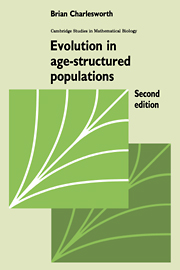Book contents
- Frontmatter
- Contents
- Preface
- Preface to the second edition
- 1 Models of age-structured populations
- 2 The genetics of populations without selection
- 3 Selection: construction of a model and the properties of equilibrium populations
- 4 Selection: dynamic aspects
- 5 The evolution of life-histories
- Appendix 1 Generating functions and their properties
- Appendix 2 Asymptotic values of ρpi and 2ρi
- References
- Author index
- Subject index
5 - The evolution of life-histories
Published online by Cambridge University Press: 18 December 2009
- Frontmatter
- Contents
- Preface
- Preface to the second edition
- 1 Models of age-structured populations
- 2 The genetics of populations without selection
- 3 Selection: construction of a model and the properties of equilibrium populations
- 4 Selection: dynamic aspects
- 5 The evolution of life-histories
- Appendix 1 Generating functions and their properties
- Appendix 2 Asymptotic values of ρpi and 2ρi
- References
- Author index
- Subject index
Summary
Introduction
This chapter is concerned with the role of natural selection in moulding the forms of life-histories, as described by the relationships of age-specific survival probability and reproduction to age. This is an aspect of the theory of natural selection which was not investigated by Charles Darwin, although Alfred Russel Wallace briefly discussed the topic (Rose, 1991, pp. 4–5). The first detailed discussion was apparently that of August Weismann (Weismann, 1889; Rose, 1991, pp. 6–7), who was primarily concerned with the evolutionary explanation of ageing. In the absence of a well-developed science of population genetics, these early attempts were necessarily confused, and led nowhere. After the rise of population genetics, Fisher (1930, Chapter 2) and Haldane (1941, pp. 192–4) both briefly discussed aspects of selection on age-specific survival, but their remarks had little immediate impact.
The modern era was initiated by Medawar (1946, 1952), who was the first to formulate clearly the concept that the strength of selection on genes affecting survival or reproduction depends on the ages at which they exert their effects. He suggested that senescence has evolved as a result of stronger selection on effects of genes which are expressed early in life than on effects expressed later on. This idea was elaborated in relation to comparative data by Williams (1957), and made quantitative by Hamilton (1966). It is discussed in section 5.2 of this chapter. A large body of work now exists which was stimulated by these basic ideas and which provides a firm connection between population genetics models of the kinds described in the last two chapters and biological data on ageing (Rose, 1991).
- Type
- Chapter
- Information
- Evolution in Age-Structured Populations , pp. 189 - 267Publisher: Cambridge University PressPrint publication year: 1994
- 3
- Cited by



